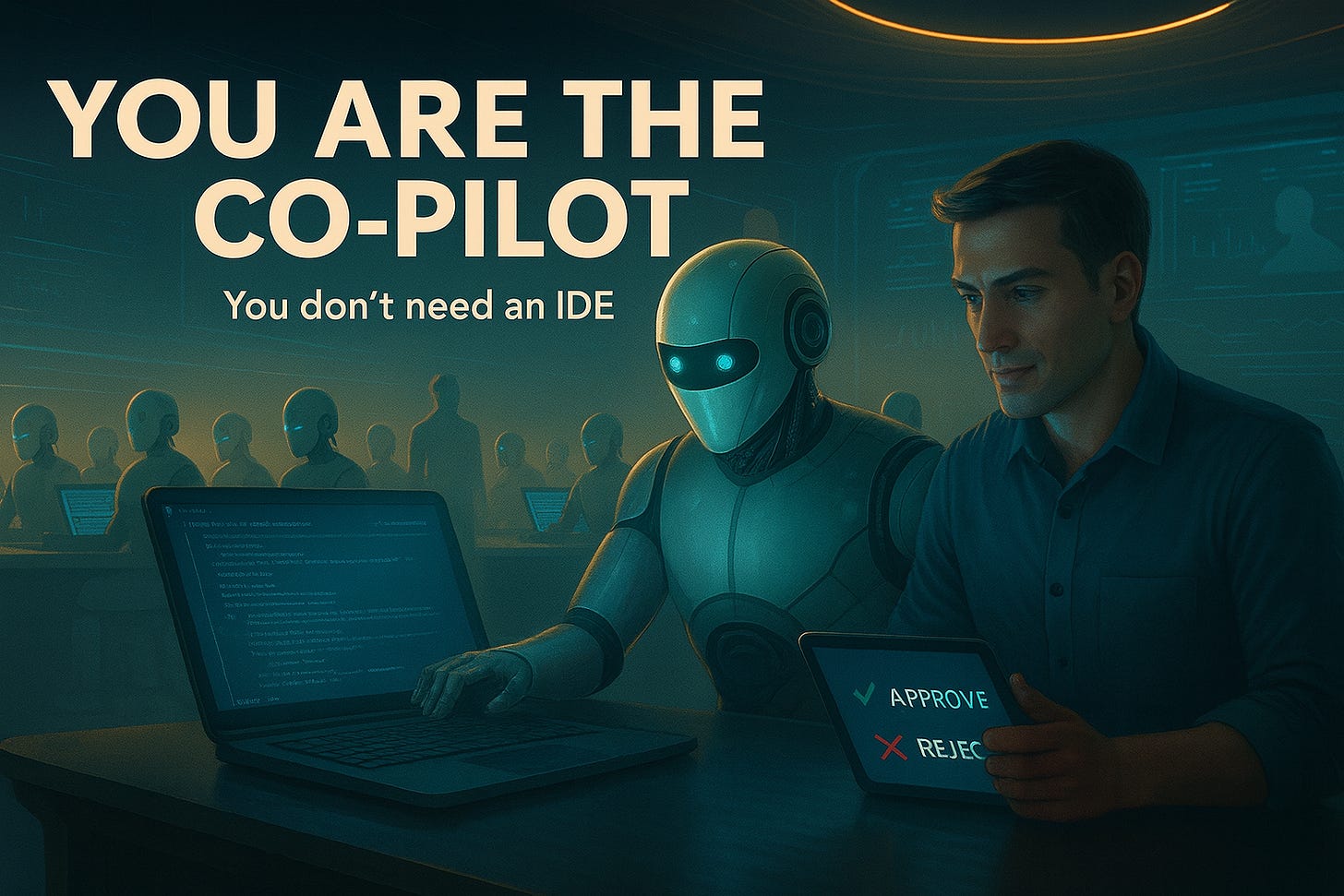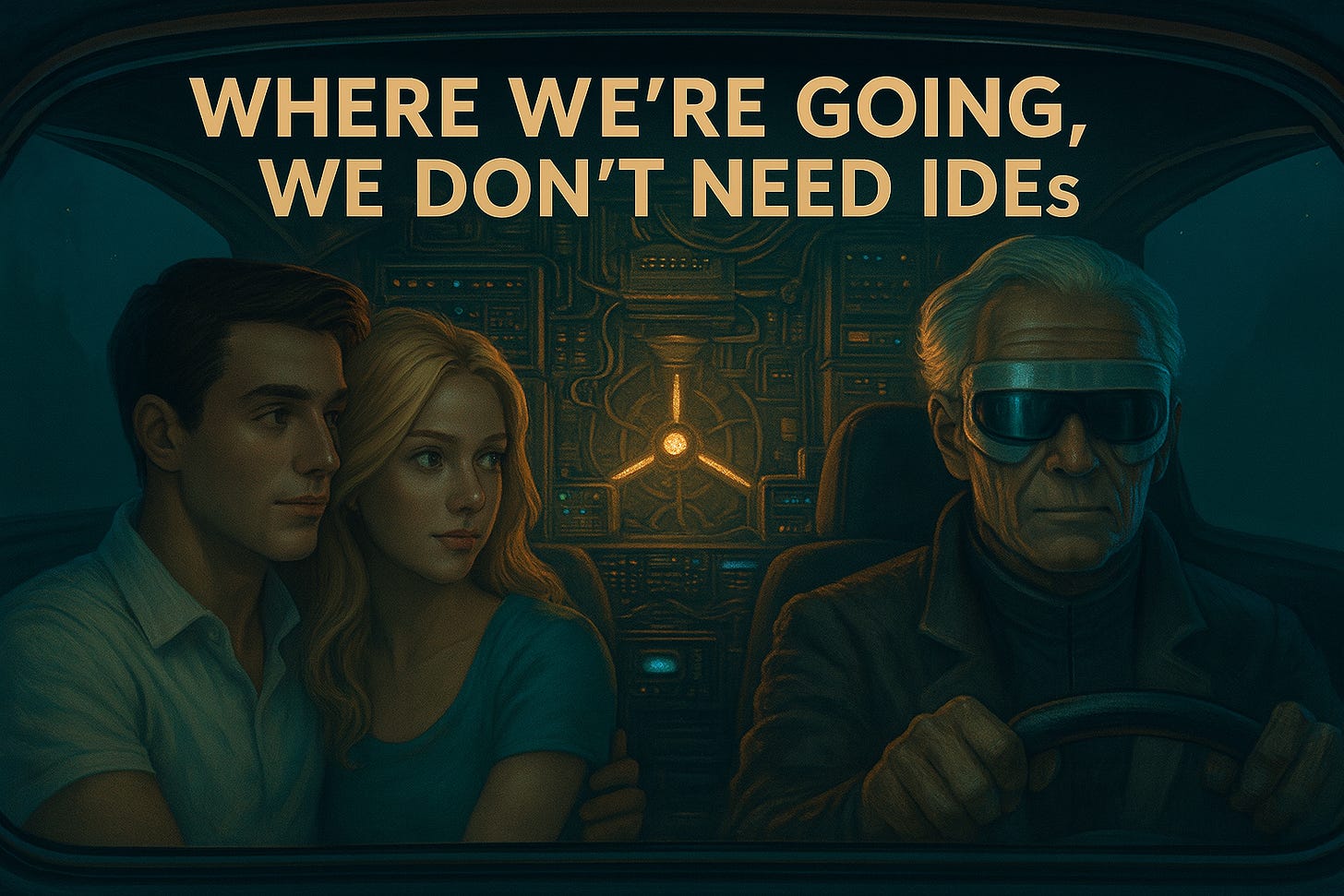With GPT-5 You Don’t Need Cursor: You Are the Co-Pilot
I haven’t used Cursor’s features for over a month now.
Don’t get me wrong, Cursor is a great product and it was a step-function above using early versions of Github Co-Pilot in VS-Code, but recently I’ve gone entirely back to the terminal. The IDE was just becoming memory overhead and I couldn’t have more than a few instances open at once without my laptop complaining about running out of memory. I’ve already been convinced we’re undergoing a transformational shift in software development for a few years now, but something uniquely changed once I started using Claude Code and forcing myself to try “vibe-coding” (despite my initial aversion to the term itself).
What really cemented the notion that we have transitioned past the event-horizon of moving into this new paradigm was some statements made by the team at OpenAI during the GPT-5 announcement livestream. They said they wanted GPT-5 to be “the ideal pair-programmer to work with.” They were demoing inside Cursor, but they barely used the screen — just a small panel showing what the model was already implementing on its own.
That’s the wrong interface.
When the agent is doing nearly all the work, you aren’t driving — you’re the co-pilot.
The job isn’t to live inside a code editor; it’s to guide and approve what’s being built. And for that, the bloated, human-centric interface of an IDE becomes a bottleneck, not a boost.
This isn’t the first time developers have gone through an interface inversion. My father — also a software engineer — still remembers moving from punch cards to terminals. He’d carry stacks of punched paper to the ‘input window’, hand them to an operator, and wait until the next day to find out if his program even compiled. The shift to terminals was a revolution: instant feedback, interactive workflows, a drastically tighter development loop.
But the human was still in the driver’s seat. You wrote the code. The computer executed it. Now, with agent-first development, that relationship is flipping entirely.
The Three Phases of AI-Assisted Coding
The move toward agent-based development isn’t binary — it’s a spectrum:
🚘 Phase 1: You’re Driving
The GitHub Copilot era. You type the code, the AI fills in small gaps. Autocomplete with flair, but you’re firmly in control.
🤝 Phase 2: You’re Pair Programming
We’re here now. Models like GPT-4o and Claude Sonnet 4 can reason deeply about architecture and implementation. You delegate entire functions, services, and refactors. We currently call it vibe coding — watching and tweaking while the agent does the heavy lifting — but we should really come up with a better term.
👨🏼✈️ Phase 3: You’re the Co-Pilot
The inversion. The agent is now the primary developer. You set goals, review diffs, and approve features like a tech lead at a big company. Models like GPT-5 and Claude Opus 4.1, especially when paired with agentic coding frameworks, push us past this threshold — they can operate autonomously within constraints and coordinate complex systems.
You’re no longer the driver. You’re the navigator. The co-pilot.
The only issue? You’re still sitting there gripping a steering wheel. What you really need is a map. A steering wheel keeps your eyes on the short-term; a map lets you chart the entire course ahead.
Where We’re Going, We Don’t Need IDEs
Modern IDEs were built for human perception — syntax highlighting, file trees, lint warnings — everything assumes you’re the one typing. As we keep moving into this new paradigm we can no longer assume this is the case. The agent is doing all the work while you’ve probably already switched to another window approving the plan of a different agent.
Now it’s waiting for you. You’re the bottleneck now.
The agent is in the race-car ready to get back on the track, but pit crew is waiting on you as the crew chief to manually check everyone’s work and give the go-ahead.
As the excellent ClaudeLog post You Are the Main Thread points out:
Before, being “unproductive” meant wasting just your own time: opportunity cost × 1.
But with AI agents, every idle moment also wastes all the parallel processes you could have initiated: (opportunity cost × 1) + (opportunity cost × N).
That’s why heavy GUI-based workflows feel mismatched. You don’t need to see the whole file — you need the diff, the intent, and the “why,” in whatever format makes approval fastest.
Right now, the terminal is making a comeback because it strips away the overhead. Commands are structured, outputs are parseable, and agents can work inside it without the clumsy mouse-and-menu dance of an IDE. But this is a bridge, not the destination.
The future is not a terminal — it’s a high-level orchestration layer that routes tasks to the right agents, equips them with the right tools, and surfaces only the decisions you need to make. The faster you unblock them, the faster the system builds itself.
You’re Not the Smartest in the Room Anymore
Engineers love puzzles. That dopamine hit from solving a gnarly bug or finally cracking a tricky algorithm is part of why we got into this work. For decades, being the person who could write the cleanest, most efficient code was how you proved your value.
But in the age of agent-first development, you’re not the fastest or most precise coder in the room anymore — not even close. Models like GPT-5 and Claude Opus 4.1 are already outclassing humans at low-level implementation, and they’re only getting faster.
That doesn’t mean you’re obsolete. It means your job is moving up the stack:
Deciding which problems to solve first
Choosing the right approach and tools
Setting constraints and quality bars
Coordinating work across multiple agents (and eventually, agent teams)
It’s the same shift that happens when a senior engineer becomes a tech lead at a FAANG company. You stop coding every line yourself and start directing the work of others — approving pull requests, reviewing architecture docs, ensuring the system as a whole works as intended.
That’s the mindset shift every developer will need to make:
From “I write the code”
To “I orchestrate the code being written”
And orchestration at scale is not something you can do manually. When you have 5, 10, or 50 agents working on different parts of a system, you need tooling to manage workflows, surface the important decisions, and make approvals painless.
Tooling for the New Hierarchy
In an agent-first workflow, there are two very different audiences for tools:
For AI Agents
Agents need tools they can call autonomously — APIs, execution environments, and specialized functions. These tools must be machine-native: predictable inputs, structured outputs, and no wasted rendering for human eyes. Think external APIs, CLI tools, and automation frameworks.
For You (the Co-Pilot)
Your tools aren’t about doing the work — they’re about directing it. You need interfaces for orchestration, approvals, and strategy. These must be human-native: visual summaries, diff views, dependency graphs, and dashboards that surface only the decisions that matter. Examples include approval dashboards, agent orchestration panels, and system architecture viewers.
The tricky part: you have to manage both layers at once.
If you’re leading multiple agents, each using a rotating set of tools, you need a system that dynamically routes the right tools to the right agents, minimizes context-switching, surfaces blockers early, and keeps everything auditable.
Your job as the co-pilot isn’t to hover over the agent’s shoulder — it’s to design and manage the ecosystem they operate in.
Conclusion: Embrace the Inversion
The history of software development is a series of interface shifts:
Punch cards → terminals
Terminals → IDEs
IDEs → ???
Each shift changed how we interact with machines, but until now, the human has always been the driver. That era is over.
We’ve crossed the midpoint of a three-phase transformation:
You’re driving – AI helps occasionally
You’re pair programming – you and the agent are equals in the IDE
You’re the co-pilot – the agent drives, you direct, approve, and scale the work
In the future, your value isn’t in how fast you type — it’s in how well you orchestrate. You’re no longer the person at the keyboard. You’re the architect, the lead, the one keeping the system aligned with the vision. The agents are your team.
That requires a new class of tooling — not just for coding, but for coordination. Tools that give agents the capabilities they need without drowning them in irrelevant options. Tools that surface only the decisions you need to make, when you need to make them. Tools that keep you out of the critical path so the system can keep moving at full speed.
That’s exactly the kind of philosophy we have at Toolprint.
We recently released HyperTool-MCP, which lets you dynamically select which tools to expose from your MCP Servers, making sure agents always have the right set of tools at the right time — without waiting on you to configure them manually. It’s a first step toward the orchestration layer that will let one human direct hundreds of agents across thousands of tools.
The shift is happening whether you like it or not. Those who adapt will 10× their output. Those who cling to old workflows will be left behind.
It’s time to switch seats. Now you are the co-pilot.



